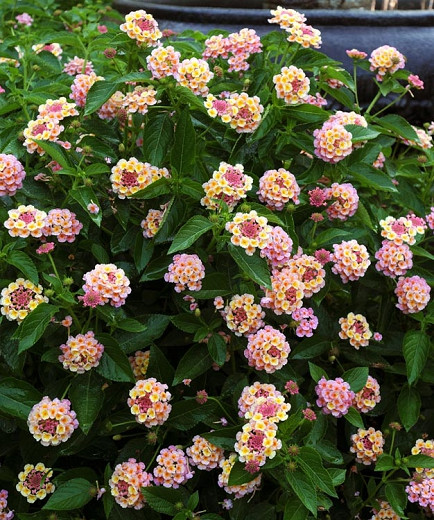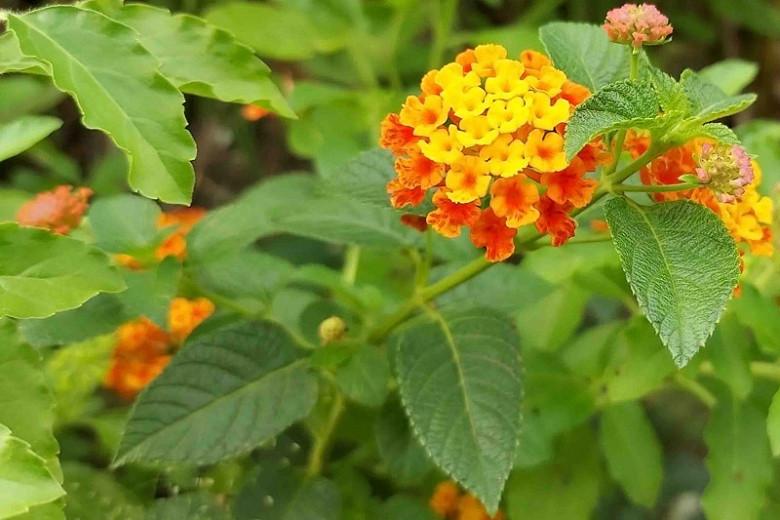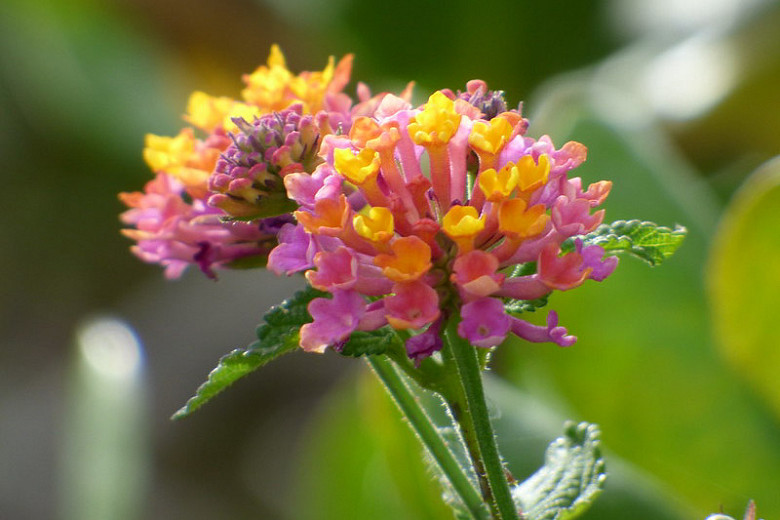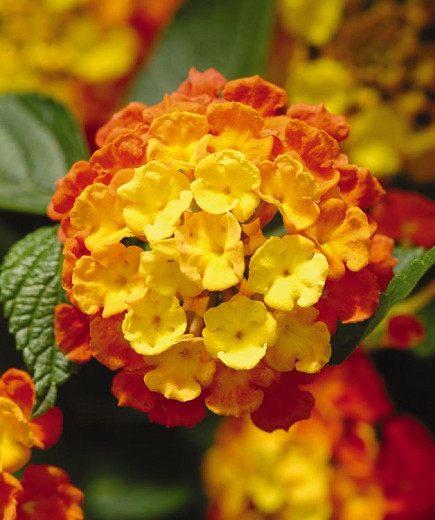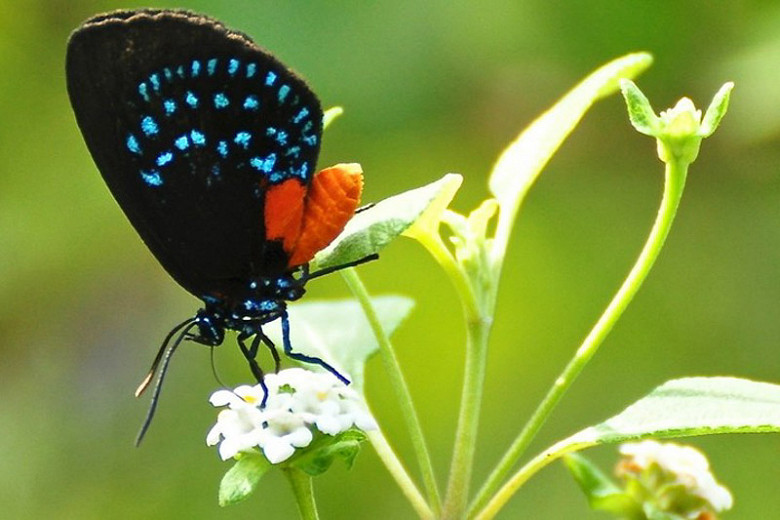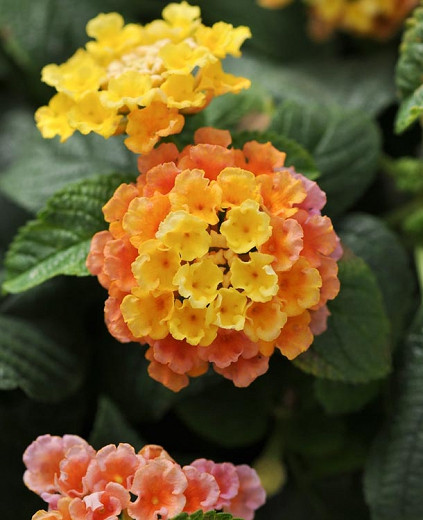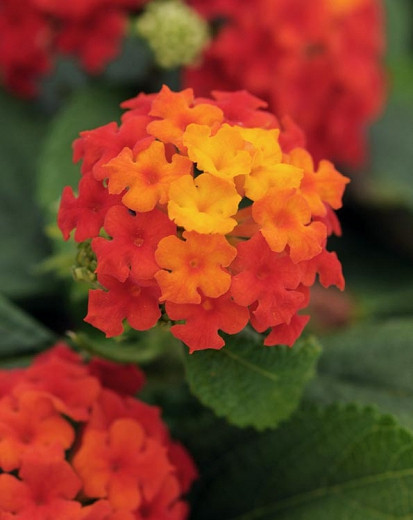Lantana camara Landmark™ Peach Sunrise (Bigleaf Lantana)
Vigorous, Lantana camara ‘Landmark Peach Sunrise’ (Bigleaf Lantana) is a sun-loving evergreen shrub forming a large bushy mound of dark green foliage which gets abundantly covered with brightly colored flower clusters, 2 in. wide (5 cm), from late spring to fall.
Vigorous, Lantana camara 'Landmark Peach Sunrise' (Bigleaf Lantana) is a sun-loving evergreen shrub forming a large bushy mound of dark green foliage which gets abundantly covered with brightly colored flower clusters, 2 in. wide (5 cm), from late spring to fall. Blooming continuously for months, the blooms open yellow and mature to salmon-peach, creating a warm color combination that attracts butterflies and hummingbirds. The ovate, toothed, wrinkled leaves are aromatic (pungent scent) when bruised. This Lantana is a tough, resilient plant valued for its long season of reliable bloom.
- Grows up to 15-20 in. high (37-50 cm) and 18-24 in. wide (45-60 cm).
- Easily grown in average, medium moisture, well-drained soils in full sun. Lantana is tolerant of all soil types (including poor soils) provided they are well drained and slightly acid.
- Thrives in extreme heat, humidity and drought. Lantana is salt tolerant, making it an excellent choice for plantings near the beach.
- Deer resistant
- Great for beds and borders, wall-side borders, banks and slopes, cottage gardens, coastal gardens, Mediterranean gardens or in containers.
- May be subject to powdery mildew if grown in shade. Root rot can be a problem if soil is poorly drained or plants are watered too frequently. Mites can be a problem, especially if plants are very dry.
- Prune back plants after first flowering to shape and to encourage additional bud growth.
- Highly toxic if ingested. Wear gloves and wash hands after handling
- Toxic to dogs, toxic to cats, toxic to horses, toxic to humans.
- Lantana camara species is native to Central and South America. It has been introduced to most of the tropics and subtropics as a hedge plant and has since been reported as extremely weedy and invasive in many countries. In addition to this, it increases the risk of fire, is poisonous to livestock and is a host for numerous pests and diseases.
- Find where this species is invasive in the United States.
- Discover beautiful U.S. native plant alternatives.
Requirements
| Hardiness | 10 – 12 |
|---|---|
| Heat Zones | 1 – 12 |
| Climate Zones | 8, 9, 10, 12, 13, 14, 15, 16, 17, 18, 19, 20, 21, 22, 23, 24, H1, H2 |
| Plant Type | Perennials, Shrubs |
| Plant Family | Lantana |
| Exposure | Full Sun |
| Season of Interest | Spring (Late)Summer (Early,Mid,Late)Fall |
| Height | 1' – 2' (30cm – 60cm) |
| Spread | 1' – 2' (30cm – 60cm) |
| Spacing | 24″ (60cm) |
| Water Needs | Low, Average |
| Maintenance | Low |
| Soil Type | Chalk, Clay, Loam, Sand |
| Soil pH | Acid, Alkaline, Neutral |
| Soil Drainage | Moist but Well-Drained |
| Characteristics | Showy, Evergreen |
| Tolerance | Deer, Drought, Rabbit, Salt |
| Attracts | Butterflies, Hummingbirds |
| Garden Uses | Banks and Slopes, Beds and Borders, Patio and Containers, Wall-Side Borders |
| Garden Styles | Coastal Garden, Informal and Cottage, Mediterranean Garden, Prairie and Meadow |
